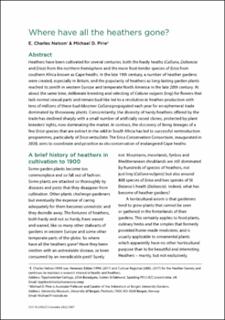| dc.description.abstract | Heathers have been cultivated for several centuries, both the hardy heaths (Calluna, Daboecia and Erica) from the northern hemisphere and the more frost-tender species of Erica from southern Africa known as Cape heaths. In the late 19th century, a number of heather gardens were created, especially in Britain, and the popularity of heathers as long-lasting garden plants reached its zenith in western Europe and temperate North America in the late 20th century. At about the same time, deliberate breeding and selecting of Calluna vulgaris (ling) for flowers that lack normal sexual parts and remain bud-like led to a revolution in heather production with tens of millions of these bud-bloomer Calluna propagated each year for an ephemeral trade dominated by throwaway plants. Concomitantly, the diversity of hardy heathers offered by the trade has declined sharply with a small number of artificially raised clones, protected by plant breeders’ rights, now dominating the market. In contrast, the discovery of living lineages of a few Erica species that are extinct in the wild in South Africa has led to successful reintroduction programmes, particularly of Erica verticillata. The Erica Conservation Consortium, inaugurated in 2020, aims to coordinate and prioritise ex situ conservation of endangered Cape heaths. | en_US |

